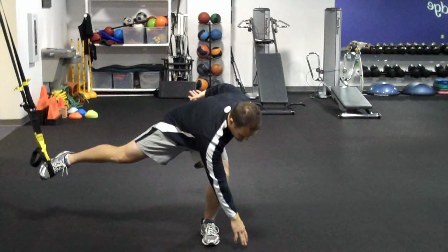
In the second part of a miniseries using theTRX Suspension Trainer, Brian demonstrates the Frontal Plane Reach,which exercises the gluteal muscle group and teaches safer dynamicplanting/cutting positions for athletes at risk for ACL injury.
See 'Related Resources' below for past Functionally Fits (including the TRX miniseries) and other exercises and training tips.
Execution
Begin with one foot suspended with the leg abducted in the TRX, the other leg parallel to the suspended leg and the fixed foot facing forward. As demonstrated in the previous progression, you can begin using a small cone (4 â½) for proprioceptive feedback and position it approximately 4-8 inches from the stance foot. If the client is able, he/she can reach to the floor as well.
This upper body reaching progression now focuses on the frontal plane with respect to the lower kinetic chain. Many of the dangerous shear forces clients are exposed to that cause knee injuries occur in the frontal and transverse plane. Training to slow and counteract adduction and internal rotation forces will undoubtedly improve knee health in our clients.

Begin with a two hand reach beyond the fixed foot. Once the client masters this, he/she can advance to a single arm cross-over reach. Reaching toward the anchor point will require more stability/control as the body moves into the line of pull as opposed to away from it. You may perform 1-3 sets of each exercise for 5-10 quality reps.


The client should be advised to maintain the knee in alignment with the foot at all times. It may be necessary to provide kinesthetic feedback (providing a bumper of sorts with your hand) at first to coach the client to avoid valgus moments.
Application
This exercise is very effective in training the gluteal muscle group (especially the gluteus medius) to maintain optimal foot/knee/hip alignment in the face of the adduction force. In addition, the rotational component forces the hamstrings to engage to help resist rotation at the knee. Finally, the desired low reaching position teaches safer dynamic planting/cutting positions for athletes at risk for ACL injury.
At first, it is generally best to start this progression with the suspended foot directly beneath the anchor point to minimize the frontal plane pulling force. Once the client demonstrates good control, you can move farther away from the anchor point to increase the difficulty. Be sure to watch the fixed foot and cue the client to keep the foot pointing forward at all times.
Precautions
As directed in the first progression, for safety and to avoid overstressing irritable tissues, you may want to modify, screen or exclude clientele (on a case by case basis) with the following conditions:
- Marked knee or hip arthritis
- Meniscus pathology
- Hip labral tears
- Active lumbar disc pathology/sciatica
- Brian Schiff, PT, CSCS (www.brianschiff.com) is a licensed physical therapist, respected author and fitness professional. He became a Certified Strength and Conditioning Specialist (CSCS) in 1998. In 2000, he opened his own personal training and sport-specific conditioning facility, Fitness Edge, in Dublin, Ohio. Brian has presented at several professional conferences and seminars on injury prevention and sport-specific training.














